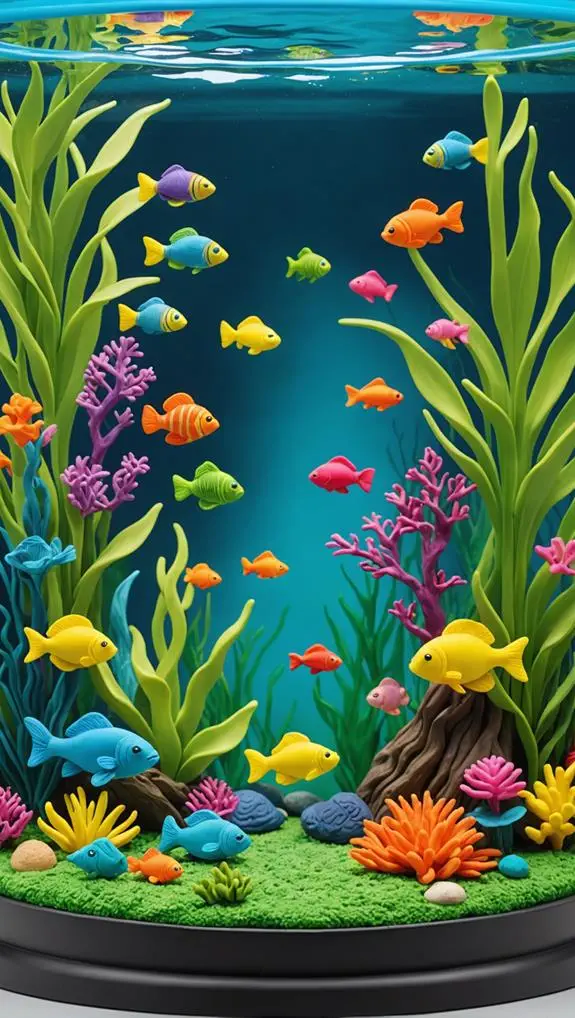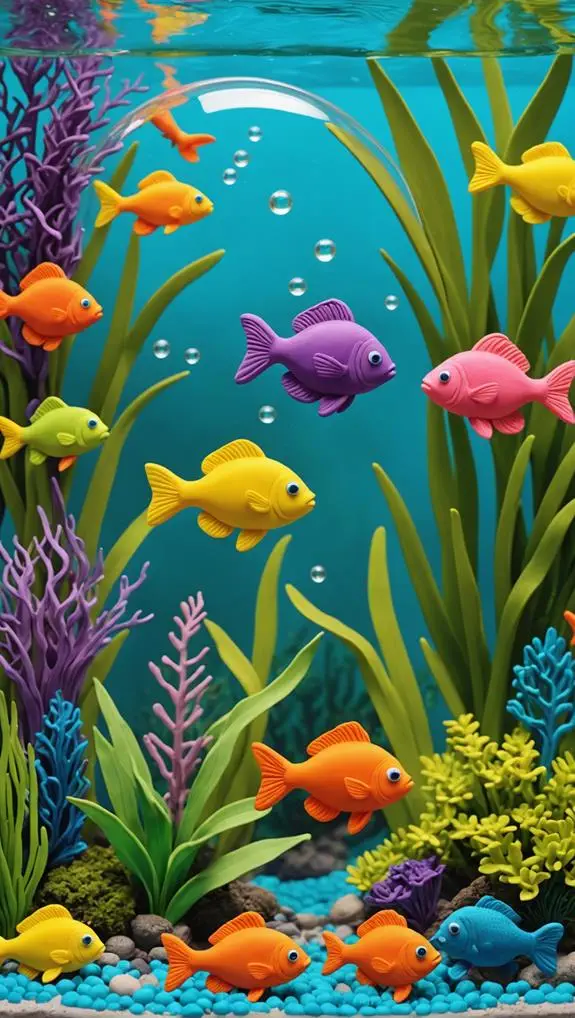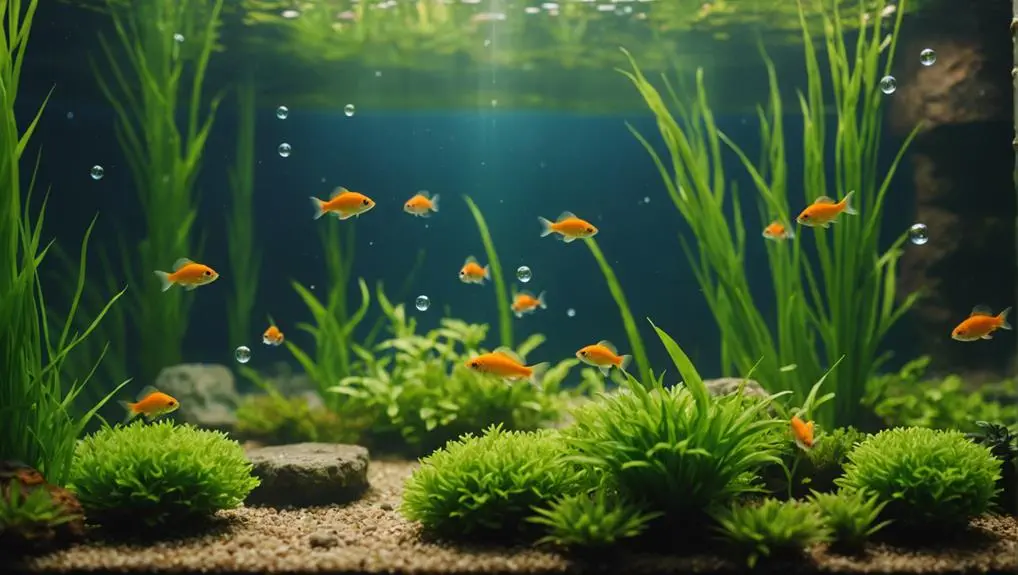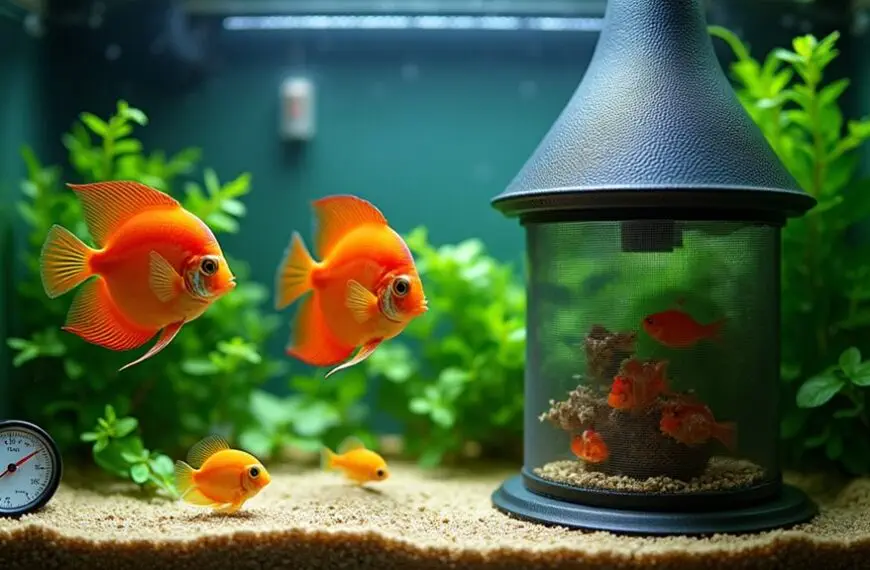To care for your fish fry, start with a clean, spacious tank filled with hiding spots like plants and caves. Keep the temperature between 74°F and 82°F, depending on the species. Regular water changes help maintain low toxin levels—nobody likes dirty water! For feeding, begin with small foods like infusoria and ramp up to brine shrimp as they grow. Don't forget to keep an eye on their health; watch for signs of stress and adjust their care as needed. With the right setup, your little swimmers will grow big and strong, and there's plenty more to explore!
Contents
Setting Up the Breeding Environment
Setting up the breeding environment is crucial for ensuring the health and survival of your fish fry. You want your breeding tank to be spacious and clean, giving adult fish room to swim and fry a cozy spot to thrive after they hatch.
Adding live plants, caves, or spawning mops will create hiding spots—think of it as their own little safe haven! Regularly testing the water parameters is essential to catch any potential issues early, ensuring optimal conditions for both parents and fry, especially during this critical time of growth and development.
Focus on those water parameters: every species has its preferences, so research what temperature, pH, and hardness work best for your fish. Many like it cozy, around 74°F to 82°F.
Regular water changes and maintenance are key to keeping toxins at bay; nobody wants a toxic party in their tank! Testing and maintenance is vital for early detection of water quality issues.
Protecting Eggs and Fry
When it comes to protecting your fish eggs and fry, ensuring their safety from parent fish is essential. You wouldn't want your little ones to become a snack, right? To protect those sticky eggs, try using spawning mops, dense plants, or ceramic tiles as secure laying surfaces.
If the eggs are scattered, marbles in the substrate or mesh screens can work wonders, creating a barrier between them and hungry adults. Establishing a properly cycled tank is important, as it contributes to a stable environment, reducing stress on the fry and increasing their chances of survival due to a balanced ecosystem cycling a fish tank lays the foundation.
For cave-spawning fish, make sure those caves are the right size. After the eggs are laid, don't forget to remove these structures to keep them safe.
In the case of mouth-brooding species like African cichlids, separating the fry from their parents shortly after birth can prevent accidental munching and helps the fry recover better.
You might also want to consider DIY traps with floating baskets. They can create safe zones within your aquarium, allowing fry to escape from adult fish, which significantly boosts their survival rate.
Maintaining Water Quality

To ensure your fry thrive, maintaining water quality is essential, as they're particularly sensitive to pollutants and sudden changes in their environment.
Clean, balanced water is crucial for their health, as harmful substances like ammonia can lead to stress and illness. Keeping their water clean doesn't have to be a chore; it's about creating a safe haven for your little swimmers.
Here are some key tips to help you maintain that pristine water quality:
- Regular water changes: Aim for 10-20% changes multiple times a week to keep ammonia, nitrites, and nitrates low, as regular maintenance is vital for overall aquarium health.
- Gentle filtration: Use sponge filters to prevent fry from getting sucked in while still ensuring clean water.
- Monitor water parameters: Keep an eye on temperature (75-80°F is ideal), pH, and hardness to meet your fry's specific needs.
- Pre-filter sponges: These can protect fry from strong currents and provide beneficial bacteria for better filtration.
- Stay consistent: Regular checks on water quality will help you catch any issues before they become a problem.
Feeding the Fry
Feeding your fry is crucial for their growth and development, especially during those early days when they rely on their yolk sac before transitioning to external food sources.
You'll want to ensure your little swimmers get the best start possible. Initially, they thrive on infusoria, green water, or finely powdered commercial fry food. These options provide vital nutrients for their budding bodies.
As they grow, freshly hatched brine shrimp become an excellent food choice. Not only are they packed with nutrition, but they also encourage the fry's natural hunting instincts. Picture those tiny fish darting around like they're on a treasure hunt!
To meet their high energy demands, feeding the fry multiple small meals throughout the day—about 3-5 times—is essential.
Don't forget to gradually increase the size of the food particles as they mature. Once your fry can handle it, introduce crushed flakes or gel foods.
This progressive approach helps them adapt and flourish, ensuring you're nurturing little fishy champions. Remember, a well-fed fry is a happy fry, and who doesn't love a little aquatic joy swimming around?
Monitoring Fry Health

Monitoring your fry's health is essential for ensuring they thrive in their early stages. You want to catch any issues before they escalate, so keep an eye on your little ones.
Here are some key areas to focus on:
- Watch for stress signs: Look for changes in color, swimming patterns, or appetite.
- Check water parameters weekly: Keep track of temperature, pH, and ammonia levels to maintain optimal conditions.
- Change the water regularly: Implement a routine for partial water changes to keep the environment clean and healthy.
- Monitor feeding times: Adjust the type and amount of food based on the fry's size and growth stage.
- Keep records: Track fry growth and any health issues to spot trends that might indicate problems.
Providing Habitat and Cover
Consistently providing a safe habitat for your fry is crucial for their survival and development. They need places to hide, away from the prying fins of adult fish. Think about adding live plants, caves, or rock formations to your aquarium.
These hiding spots can significantly increase the fry's survival rate, offering them protection as they grow.
Incorporating spawning mops or dense vegetation not only helps secure sticky eggs but also gives fry a cozy refuge. You might even consider DIY traps with floating plant baskets or craft mesh.
These clever setups create designated areas where fry can escape predation.
Plants like java moss and dwarf water lettuce serve as natural shelters, encouraging fry to explore their new world safely. Plus, they look lovely in your tank!
If you establish a colony breeding setup, make sure there's plenty of cover. This way, fry can thrive alongside their parents without the constant fear of being snacked on.
Frequently Asked Questions
How to Take Care of Fish Fry?
To take care of fish fry, maintain optimal water quality, choose an appropriate tank size, and regulate temperature carefully. Provide hiding spots and feed them small, nutritious meals multiple times a day for healthy growth.
What Do Fry Need to Survive?
To ensure fry survive, you need to maintain excellent water quality and create a supportive tank environment. Focus on stable conditions, provide quality food, and monitor their growth to foster healthy development and well-being.
How Many Times a Day Should I Feed My Fish Fry?
You should feed your fish fry 3 to 5 times daily. This feeding schedule promotes fry health by ensuring they receive proper nutrition. Adjust portion sizes based on their growth and behavior for optimal development.
What Is the Best Feed for Fish Fry?
You'll want to offer a mix of commercial feeds and natural foods, like infusoria and brine shrimp. Establish a feeding schedule that gradually introduces larger food particles as fry grow, ensuring their nutritional needs are met.
Final Thoughts
Taking care of fish fry might seem overwhelming, but it can be a rewarding adventure! Just remember, they're not just tiny fish; they're little lives that need your attention. By setting up a safe environment, maintaining clean water, and feeding them well, you're giving them a great start. It's like being a fish parent! So, dive in, have fun, and watch them grow. Who knows, you might find your new favorite hobby in the process!












